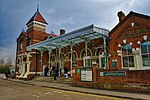Church of Our Lady and St Peter, Leatherhead
1923 establishments in England20th-century Roman Catholic church buildings in the United KingdomEngvarB from September 2019Gothic Revival architecture in SurreyGothic Revival church buildings in England ... and 3 more
LeatherheadRoman Catholic churches completed in 1923Roman Catholic churches in Surrey

The Church of Our Lady and St Peter is a Roman Catholic church in Leatherhead, Surrey. It was founded as a local chapel during the First World War and later became a Parish church. It is situated between Copthorne Road and Garlands Road on the junction with St John's Avenue in Leatherhead. It is the only Catholic church in Leatherhead and is served by the Diocese of Arundel and Brighton.
Excerpt from the Wikipedia article Church of Our Lady and St Peter, Leatherhead (License: CC BY-SA 3.0, Authors, Images).Church of Our Lady and St Peter, Leatherhead
Garlands Road, Mole Valley
Geographical coordinates (GPS) Address Nearby Places Show on map
Geographical coordinates (GPS)
| Latitude | Longitude |
|---|---|
| N 51.3 ° | E -0.324579 ° |
Address
Garlands Road
Garlands Road
KT22 7EZ Mole Valley
England, United Kingdom
Open on Google Maps







